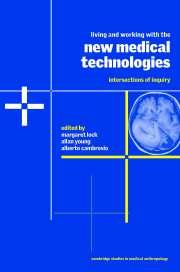Book contents
- Frontmatter
- Contents
- List of contributors
- 1 Introduction
- Part I Epochal transitions? Biomedicine and the transformation of socionature
- Part II Laboratories and clinics: the material cultures of biomedicine
- Part III Technologies and bodies: the extended networks of biomedicine
- 8 Screening the body: the pap smear and the mammogram
- 9 Extra chromosomes and blue tulips: medico-familial interpretations
- 10 When explanations rest: “good-enough” brain science and the new socio-medical disorders
- 11 On dying twice: culture, technology and the determination of death
- 12 The practice of organ transplants: networks, documents, translations
- Index
8 - Screening the body: the pap smear and the mammogram
Published online by Cambridge University Press: 23 December 2009
- Frontmatter
- Contents
- List of contributors
- 1 Introduction
- Part I Epochal transitions? Biomedicine and the transformation of socionature
- Part II Laboratories and clinics: the material cultures of biomedicine
- Part III Technologies and bodies: the extended networks of biomedicine
- 8 Screening the body: the pap smear and the mammogram
- 9 Extra chromosomes and blue tulips: medico-familial interpretations
- 10 When explanations rest: “good-enough” brain science and the new socio-medical disorders
- 11 On dying twice: culture, technology and the determination of death
- 12 The practice of organ transplants: networks, documents, translations
- Index
Summary
The field known as social studies of science is the province of those researchers who find science exciting at a philosophical and theoretical level, but who also are fascinated by scientists and what they do. Like the children and the governess in A. S. Byatt's story, “Morpho Eugenia” (1992), who watched and recorded the comings and goings and battles of the ant colonies, they observe the scientists. They sit in their laboratories, attend their meetings, collect their writings and persuade them to talk about their craft and their colleagues. If Latour's image of the black box is substituted for Byatt's ants, they want to lift the lid, peer inside the box, and make visible its contents. Once the period of observation is over, the researcher turns off the light, puts the lid back on the box and walks away. For understanding what goes on within the interior of the black box is an end in and of itself. How the box is sited in relation to the wider world seems of interest only insofar as this world impinges on events within the box. Hence, some critics have complained that too little attention is paid to the “processes of transmission of innovative knowledge from the benches of the laboratory scientist to the bedside of the patient” (Batchelor et al. 1996: 48).
Set against the complexity and diversity of the other chapters in this book, my characterization of social studies in science is clearly an over-simplification. Yet, like most over-simplifications, it is rooted in a grain of truth.
- Type
- Chapter
- Information
- Living and Working with the New Medical TechnologiesIntersections of Inquiry, pp. 165 - 183Publisher: Cambridge University PressPrint publication year: 2000
- 14
- Cited by



